Round Top Festival Institute: No Ordinary Dream

2025 Spring Antiques Show | March 20 – April 6
2025 Fall Antiques Show | October 4 – 18

Internationally acclaimed concert pianist James Dick asks: Why dream the ordinary?
Master carpenter Larry Birkelbach maintains: The impossible just takes longer.
Two men. Four hands. One goal: to build an inimitable institution that’s existence celebrates art and architecture.
The result: Round Top Festival Institute, an international center for performance and learning that is, according to Dick, a “highly reputable place for young musicians to hone their craft and talent.”
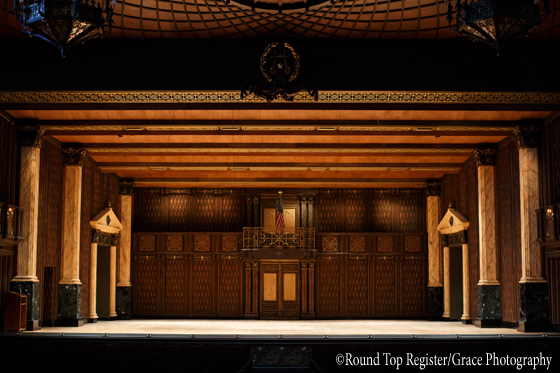 The two men, along with Richard Royall, Lamar Lentz, Alain Declert and Birkelbach’s talented craftsmen, translate ideas gathered from around the world into stunning reality. In 2020, Festival Hill will celebrate its 50th anniversary.
The two men, along with Richard Royall, Lamar Lentz, Alain Declert and Birkelbach’s talented craftsmen, translate ideas gathered from around the world into stunning reality. In 2020, Festival Hill will celebrate its 50th anniversary.
Beginning with six acres and one 19th century school house purchased at a foreclosure sale in 1971, Festival Institute now encompasses 210 acres and 18 buildings including the 1,000-seat Festival Concert Hall, which is not only one of the nation’s most acoustically perfect performance venues but with its rich Gothic-inspired woodwork arguably one of the most beautiful. The institute’s other historic public facilities are picture-perfect studies in restoration and preservation.
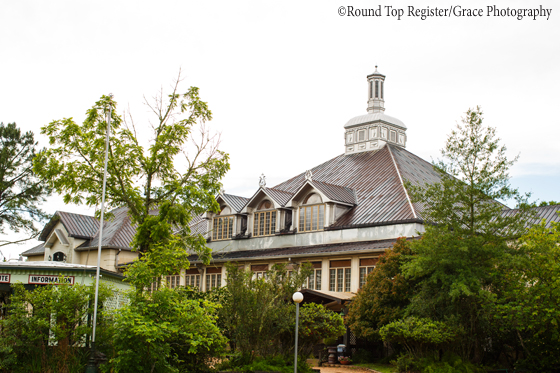 Despite the institute’s magnitude, no one ever lost sight of the importance of human scale. Festival Hill was designed to be a place where curious people could meet, explore ideas and create relationships to support and inspire one another. Throughout the year, the institute hosts forums on topics ranging from poetry and theater to herbs as well as a variety of performances including dance, puppetry and, of course, music.
Despite the institute’s magnitude, no one ever lost sight of the importance of human scale. Festival Hill was designed to be a place where curious people could meet, explore ideas and create relationships to support and inspire one another. Throughout the year, the institute hosts forums on topics ranging from poetry and theater to herbs as well as a variety of performances including dance, puppetry and, of course, music.
Each summer about 100 of the world’s most promising music students, chosen by blind auditions of more than 700 applicants, gather for six weeks of intensive, advanced study with some of the world’s most gifted teachers and conductors. The students maintain a rigorous schedule of rehearsals and weekly performances that mimics the demands of a major symphony orchestra thus preparing them for the world beyond formal education.
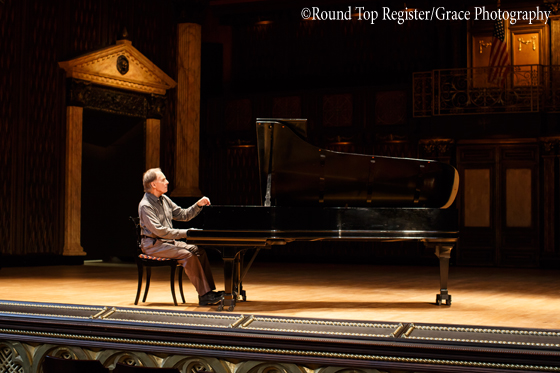 “I’m a concert pianist. That’s my life—and I’ve been so very fortunate,” Dick said. “Talent is fulfilled by studying, performing and giving your talent away by sharing what you’ve learned with others. The creation of this place is my way of giving back by serving the needs of prospective great musicians so they can carry on the tradition of excellence.”
“I’m a concert pianist. That’s my life—and I’ve been so very fortunate,” Dick said. “Talent is fulfilled by studying, performing and giving your talent away by sharing what you’ve learned with others. The creation of this place is my way of giving back by serving the needs of prospective great musicians so they can carry on the tradition of excellence.”
The magnificence of Festival Concert Hall can be traced to Birkelbach’s hands, Dick’s ears and the team’s willingness to work in the moment.
“There were no plans for the interior of the concert hall, neither for the finish or the acoustics,” Birkelbach said. “It was a fluid process of transforming visions into physical realities.”
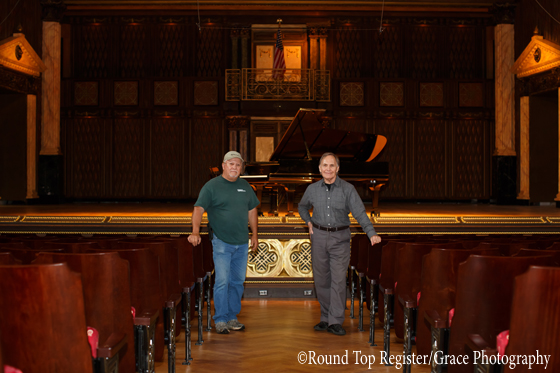 For instance, Dick didn’t want a proscenium, the portion of the stage that extends beyond the curtain, and he personally determined how tall the columns should be to create the perspective. From the beginning, sound was the primary consideration.
For instance, Dick didn’t want a proscenium, the portion of the stage that extends beyond the curtain, and he personally determined how tall the columns should be to create the perspective. From the beginning, sound was the primary consideration.
“I was just a naïve musician,” Dick said. “We didn’t use an acoustical engineer. Instead, I just moved around the space and listened as the building progressed through different phases of construction. Real wood is the genesis of this place and the sound.”
The metal framework is clad all in pine, a soft wood, with the exception of the dividers, which are poplar, a hard wood. The elaborate woodwork, such as the compass stars and the Gothic-inspired balcony fronts, adds more than visual appeal.
“Because of the multi-layered surfaces, the sound continues to move through the room,” Birkelbach said. “That’s why there’s not a bad seat in the house.”
 During early concerts, Dick would move around listening to the performance noting where the sounds were too flat or too strong. Then Birkelbach and his crew would modify the woodwork in that particular section of the hall accordingly.
During early concerts, Dick would move around listening to the performance noting where the sounds were too flat or too strong. Then Birkelbach and his crew would modify the woodwork in that particular section of the hall accordingly.
The concert hall’s ceiling is suspended by 600 steel rods. An attic rises for 20 feet above it creating the experience of sitting inside an instrument. The back wall and ceiling of the stage are pitched so the tiniest sound rolls off and over the audience. The design was modified when it was discovered that the stage’s original design negatively affected the key of C.
“No one will ever know just how much time we spent considering the details,” Birkelbach said.
The painstaking attention to details created a space that inspires all who enter it. Dick and Birkelbach take pleasure in quietly watching first-time visitors absorb the concert hall’s magnificence.
“Sometimes I look around and am amazed at what this place has become,” Dick said. “It seems surreal until I remind myself that we envisioned every detail. We wanted people to be intrigued by what they see and hear.”
He continued, “Festival Hill has so many layers because people have so many layers. If you don’t have layers, then you’re not living right.”
“Sometimes I look around and am amazed at what this place has become. It seems surreal until I remind myself that we envisioned every detail. We wanted people to be intrigued by what they see and hear.” James Dick
“As a performer, you must work as hard as you can, be critical of yourself, be humble about your talent and share it. Helping educate and develop the next generation of accomplished musicians is the way I’ve chosen to give back.
Through the years, thousands of young performers have come through here—all on scholarship. It costs about $6,000 per student, and we host about 100 students a year. The task of fundraising is huge, and I get a lot of ‘advice’ encouraging me to charge the students.
My response is that these young people are already ‘hocked up to their ears’ paying for their formal educations. If they have to pay for this as well, many would either have to borrow additional money or forgo the opportunity for supplemental advanced study because they have to work.
 The students tell me they couldn’t participate without the scholarships. That, along with the fact that I couldn’t have completed my studies without the generosity of scholarship donors, just makes me more stubborn
The students tell me they couldn’t participate without the scholarships. That, along with the fact that I couldn’t have completed my studies without the generosity of scholarship donors, just makes me more stubborn
We keep the costs down because many of the instructors and conductors donate their time or work for greatly reduced fees. They, too, have a proprietary interest in the program’s success and continuing our collective tradition of musical excellence. We have thousands of alumni all over the world who are now giving of themselves to spread the passion.
As I said, we bring well-respected international conductors to work with the students. Although we’ve never had a formal conductor’s workshop, we’ve got six former music students who have gone on to lead orchestras as conductors. Because of the human scale of Festival Hill, the students and the visiting conductors have a chance to get to know one another. When the students expressed interest, the conductors shared their knowledge and sometimes allowed them to conduct. They planted the seeds of a new passion. It’s an adjunct I’d not considered.
Our institute offers a simple, direct way to learn because the connection between people is simple, direct and authentic.”
“Everyone who is looking for a challenge should have the chance to build a concert hall without any drawings. No drawings means that no problems have been solved beforehand, so the problems reveal themselves in the building process.
Let me clarify; there were structural drawings for the building’s metal framework but none for the interior finish. Eventually, the interior was entirely clad in wood.
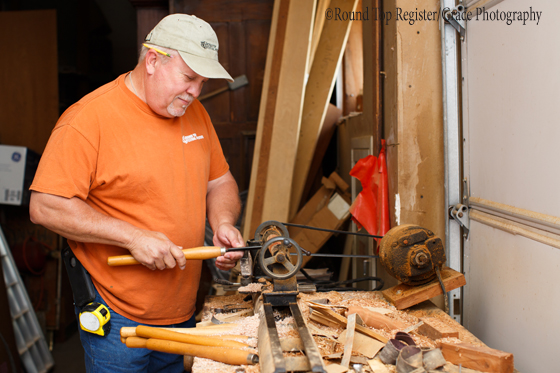 Jimmy, Richard and Lamar would bring ideas they collected during their travels to me and the crew to see if we could make them work. We’d make a sample and show it to them. If they liked it, then I would refine it, and we’d replicate it. If they didn’t like it, then we’d make another sample until we got one they liked.
Jimmy, Richard and Lamar would bring ideas they collected during their travels to me and the crew to see if we could make them work. We’d make a sample and show it to them. If they liked it, then I would refine it, and we’d replicate it. If they didn’t like it, then we’d make another sample until we got one they liked.
One day Arnold Prasifka and I were working upstairs at the Menke House, and Richard walked in and said, ‘I have something for you.’ I was reluctant to hold out my hand because Richard is quite a prankster, but when I finally took what he offered, it was a postage stamp with the Rose Window on it.
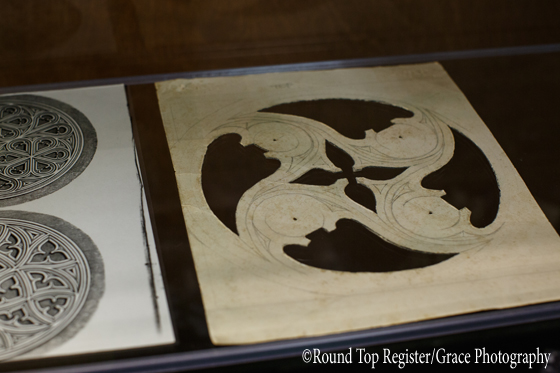 I had to ‘blow up’ the dimensions from postage stamp size to the size that would work in a large scale. We made the first medallion to adorn the bar in the Menke House, and they liked it so much that we incorporated it into the concert hall. The Rose Window design was repeated 110 times as the front of one-half of the balcony boxes. The other 110 balcony boxes are each individual designs.
I had to ‘blow up’ the dimensions from postage stamp size to the size that would work in a large scale. We made the first medallion to adorn the bar in the Menke House, and they liked it so much that we incorporated it into the concert hall. The Rose Window design was repeated 110 times as the front of one-half of the balcony boxes. The other 110 balcony boxes are each individual designs.
The ‘swirl pattern’ that surrounds the compass stars on the concert hall ceiling was inspired by a cut glass dinner plate Richard found. I drew out the swirl pattern on a piece of ripped cardboard that was just laying around and then had to transfer those measurements to the ceiling. I had to actually draw the swirl pattern on the ceiling because the perspective from the floor to the ceiling would have been skewed. Eventually, we installed five miles of wood trim to complete the pattern.
I threatened to break that plate many times. Richard just laughed and said, ‘Go ahead. I have 11 more.’
In another instance, the octagonal portions of the concert hall ceiling came from a drawing of an inlaid quilted ceiling. When Richard brought me the design, it was about the size of a sheet of notebook paper. He said, ‘I think I want to do that along the sides.’ I happened to have a 4’ x 8’ sheet of plywood, and I cut it in half so I had a 4’ x 4’ square.
I built one octagon and hung it. Jimmy loved it. I told him that I didn’t know if it was the right size, and there was only way to be sure. So I went up on the third floor and drew out the dimensions and laid the pattern on the wall. When I was done there was 1/2” inch clearance on either side. As it turned out, 4’ x 8’ was a perfect size—and it just happened to be piece of material I had on hand.
Some people would say it was luck, but I think it was divine intervention. Too many things just ‘worked out’ too often for it to be luck.
Flying by the seat of our pants has been quite a ride. I don’t claim much knowledge, but I do know how to improvise. This entire project has been improvisation on a grand scale because every day we were turning ideas into physical reality.
It’s probably a good thing that I’m a hard-headed German who refuses to quit.”
“I never master a piece of music. In fact, I’m very critical of my playing, and I still practice every day. Practicing is my favorite part of the process.
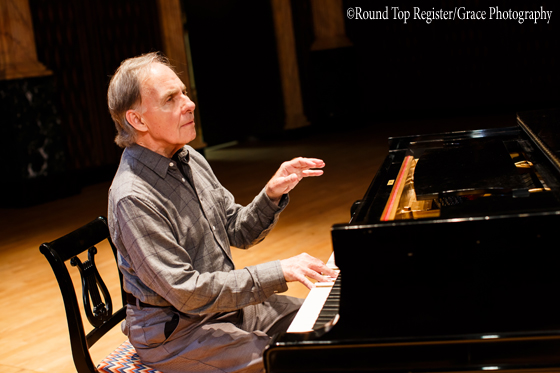 Music is a re-creative art. I approach music just as an actor approaches the words of a play, considering how to express the meaning most fully. But I also have to consider the music as a director would contemplate a play and ask myself, ‘Do I understand the intent behind the piece?’
Music is a re-creative art. I approach music just as an actor approaches the words of a play, considering how to express the meaning most fully. But I also have to consider the music as a director would contemplate a play and ask myself, ‘Do I understand the intent behind the piece?’
I study the score for clues as to the composer’s intent.
To me the expression comes in the time that lapses between depressing two notes. It adds emphasis. Timing is critical. One can languish over sound and then the structure collapses. It’s all a matter of interpretation and experience. Of course, you have to have technical proficiency to communicate the music’s basic message.
The piano has to be a ‘vocal’ instrument. Pianists use their fingers to create a note just as vocalists use their throats. In both cases, legato is the act of connecting the notes. They are interwoven as tightly as the threads of a fine tapestry with each one lending strength and color. It’s up to the pianist to discover the intricacies that hold it all together in a unified whole.
Sir Clifford Curzon, one of my teachers, told me that a good musician studies the piece and knows what he wants to do ahead of time, but then he breathes and lets the performance become something of the moment, loosening it without losing it. It is critical to be inspired in the moment because the magic of a performance comes from what you bring to that specific time, place and audience.
When I stop to think about it, Festival Institute—and its magic—is actually the result of a long series of inspired moments.”
It took Michelangelo four years to complete the ceiling of the Sistine Chapel. It took Larry Birkelbach and his three-man crew 20 years to complete the interior of the Festival Concert Hall.
# of steel rods supporting the concert hall’s suspended ceiling…600
# of wooden diamonds adorning the concert hall…10,000
# of passes through the table saw to create each diamond…32
# of Rose Window balcony faces…110
# of one-of-a-kind balcony faces…110
# of steps to complete each piece of each balcony face…6
(Each piece of each design had to be traced, cut out, routered, mounted, stained and sealed.)
# of five-point stars stacked to create the concert halls iconic compass stars…8
# of total points per star…40
# of times chairs were set up/taken down for concerts during construction…1200
# of chairs…600

The 46th Annual Round Top Festival opens on Saturday, June 11, and closes on Saturday, July 16. More than 90 young artists, arriving on June 5 to study with distinguished international faculty, will be in residence. They perform on weekends as the Texas Festival Orchestra.
The orchestral and chamber repertoire includes works by composers ranging from Beethoven, Mozart and Shostakovich to Dvorak, Hayden and Mahler and many more. Concerts are held in the Festival Concert Hall and in the Edythe Bates Old Chapel. For more information or to purchase tickets, go to www.festivalhill.org or call 979-249-3129.
Master classes, orchestra rehearsals and in-house events are open to the public free of charge.
by Lorie Woodward Cantu
photos by Anna Spencer Morse, Grace Photography
2025 Spring Antiques Show | March 20 – April 6
2025 Fall Antiques Show | October 4 – 18